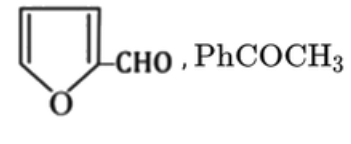How many of these molecules can have any type of
hydrogen bonding.
Glucose,HF,R−OH,R−COOH,R2NH,CCl3CHO,Ph−Br,
o−nitrophenol,PH3.
The correct Answer is:7.00
To determine how many of the given molecules can exhibit hydrogen bonding, we need to analyze each molecule based on the presence of hydrogen atoms bonded to highly electronegative atoms (like oxygen, nitrogen, or fluorine) and the presence of lone pairs on these electronegative atoms.
1. Glucose (C6H12O6):
- Glucose contains multiple hydroxyl (–OH) groups.
- The hydrogen atoms in these –OH groups can participate in hydrogen bonding with other electronegative atoms.
- Conclusion: Glucose can form hydrogen bonds.
2. HF (Hydrogen Fluoride):
- HF consists of hydrogen bonded to fluorine, which is highly electronegative.
- The hydrogen atom can form hydrogen bonds with other electronegative atoms.
- Conclusion: HF can form hydrogen bonds.
3. R-OH (Alcohols):
- Alcohols have hydroxyl (–OH) groups.
- The hydrogen in the –OH group can participate in hydrogen bonding.
- Conclusion: R-OH can form hydrogen bonds.
4. R-COOH (Carboxylic Acids):
- Carboxylic acids contain both a hydroxyl (–OH) and a carbonyl (C=O) group.
- The hydrogen in the –OH can form hydrogen bonds, and carboxylic acids often dimerize through hydrogen bonding.
- Conclusion: R-COOH can form hydrogen bonds.
5. R2NH (Secondary Amines):
- Secondary amines have hydrogen atoms attached to nitrogen, which is electronegative.
- The hydrogen can participate in hydrogen bonding with other electronegative atoms.
- Conclusion: R2NH can form hydrogen bonds.
6. CCl3CHO (Trichloroacetaldehyde):
- This molecule has no hydrogen atoms attached to highly electronegative atoms like O or N.
- The chlorine atoms do not contribute to hydrogen bonding.
- Conclusion: CCl3CHO cannot form hydrogen bonds.
7. Ph-Br (Bromobenzene):
- Bromobenzene has no hydrogen atoms attached to electronegative atoms.
- The bromine atom does not provide a site for hydrogen bonding.
- Conclusion: Ph-Br cannot form hydrogen bonds.
8. Ortho-nitrophenol:
- Ortho-nitrophenol has a hydroxyl (–OH) group and a nitro (–NO2) group.
- The hydrogen in the –OH can form hydrogen bonds, and it can also participate in intramolecular hydrogen bonding due to the proximity of the nitro group.
- Conclusion: Ortho-nitrophenol can form hydrogen bonds.
9. PH3 (Phosphine):
- Phosphine has hydrogen atoms bonded to phosphorus, which is not sufficiently electronegative to form hydrogen bonds.
- Conclusion: PH3 cannot form hydrogen bonds.
Final Count of Molecules that Can Form Hydrogen Bonds:
- The molecules that can form hydrogen bonds are: Glucose, HF, R-OH, R-COOH, R2NH, and Ortho-nitrophenol.
- Total: 6 molecules can form hydrogen bonds.
Summary of Conclusions:
- Molecules that can form hydrogen bonds: Glucose, HF, R-OH, R-COOH, R2NH, Ortho-nitrophenol.
- Molecules that cannot form hydrogen bonds: CCl3CHO, Ph-Br, PH3.
- Glucose contains multiple hydroxyl (–OH) groups.
- The hydrogen atoms in these –OH groups can participate in hydrogen bonding with other electronegative atoms.
- Conclusion: Glucose can form hydrogen bonds.
- HF consists of hydrogen bonded to fluorine, which is highly electronegative.
- The hydrogen atom can form hydrogen bonds with other electronegative atoms.
- Conclusion: HF can form hydrogen bonds.
- Alcohols have hydroxyl (–OH) groups.
- The hydrogen in the –OH group can participate in hydrogen bonding.
- Conclusion: R-OH can form hydrogen bonds.
- Carboxylic acids contain both a hydroxyl (–OH) and a carbonyl (C=O) group.
- The hydrogen in the –OH can form hydrogen bonds, and carboxylic acids often dimerize through hydrogen bonding.
- Conclusion: R-COOH can form hydrogen bonds.
- Secondary amines have hydrogen atoms attached to nitrogen, which is electronegative.
- The hydrogen can participate in hydrogen bonding with other electronegative atoms.
- Conclusion: R2NH can form hydrogen bonds.
- This molecule has no hydrogen atoms attached to highly electronegative atoms like O or N.
- The chlorine atoms do not contribute to hydrogen bonding.
- Conclusion: CCl3CHO cannot form hydrogen bonds.
- Bromobenzene has no hydrogen atoms attached to electronegative atoms.
- The bromine atom does not provide a site for hydrogen bonding.
- Conclusion: Ph-Br cannot form hydrogen bonds.
- Ortho-nitrophenol has a hydroxyl (–OH) group and a nitro (–NO2) group.
- The hydrogen in the –OH can form hydrogen bonds, and it can also participate in intramolecular hydrogen bonding due to the proximity of the nitro group.
- Conclusion: Ortho-nitrophenol can form hydrogen bonds.
- Phosphine has hydrogen atoms bonded to phosphorus, which is not sufficiently electronegative to form hydrogen bonds.
- Conclusion: PH3 cannot form hydrogen bonds.
- The molecules that can form hydrogen bonds are: Glucose, HF, R-OH, R-COOH, R2NH, and Ortho-nitrophenol.
- Total: 6 molecules can form hydrogen bonds.
- Molecules that can form hydrogen bonds: Glucose, HF, R-OH, R-COOH, R2NH, Ortho-nitrophenol.
- Molecules that cannot form hydrogen bonds: CCl3CHO, Ph-Br, PH3.
Similar Questions
Knowledge Check
Which of the following molecule have (2R, 3-2) configuration?
A B
B C
C D
D
How many of these compounds can show positive test for Hinsberg reagent

(Ph)3N, Ph−CH2OH
View SolutionCompounds showing hydrogen bonding among HF,NH3,H2SandPH3 are
View SolutionHow many of these compounds can undergo cannizzaro reaction here
CH3CHO,CH3COCH3,HCHO,Ph−CHO,Ph−CO−CHO, , PhCOCH3
, PhCOCH3
View SolutionHow many of the following groups are ortho,para directing and ring activating?
−NO2,−CN,−CH3,−OH,−NH2,
−OR,−X,−CHO,−NHR
View SolutionHow many of these compounds can reduce Tollen's reagent here?
HCHO,Ph−CHO,Ph−COCH3,CH3COCH3,CH3−C∣∣OH2OH
Glucose, CH3CH2OH
View SolutionHow many of these acids are monobasic in nature?
H2S,H2O2,HCOOH,H3BO3,H3PO2,HXO4,Ph−SO3H
View SolutionHow many among the following species can be classified as Lewis acids?
⊕CH3,Cl⊕,CO2,CCl2,BCl3,BI3,Fe+2,AlCl3
View Solution
